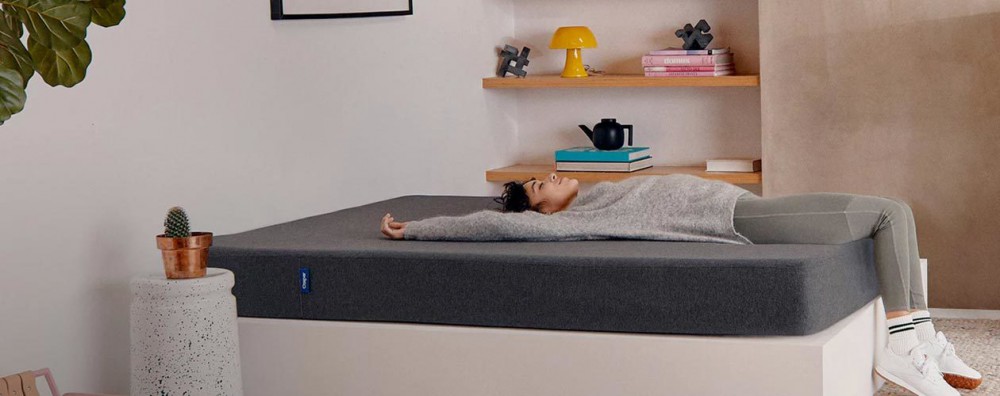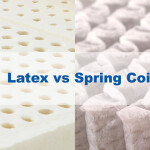What are the Different Types of Mattresses?

It seems human beings will not be happy with the humble mattress until it has been improved into a high functioning, space-age example of sleep innovation. But it is that striving for a better night’s sleep that has continued to keep the mattress industry growing and evolving over the years.
Technology that is available today is far superior to what the options were as recently as 10 years ago. We are no longer simply choosing mattress sizes with little variance in firmness or construction. Today, we are choosing from several different types; all of which have their own benefits. Let’s take a closer look.
History
In the Neolithic era, human beings were content with merely sleeping above the pests and dirt that littered the ground.
The mattress has evolved dramatically since its humble Neolithic beginnings as a rudimentary platform above the floor.
The ancient Egyptians slept on piles of palm boughs, and the ancient Persians invented the first waterbed by filling goatskins with water.
Nowadays, shoppers can buy their mattress online and from one of the dozens of brands and in a variety of sizes, models, and types.
Innerspring
Innerspring mattresses utilize a support system of metal coils, surrounded in varying layers and materials of padded upholstery.
Steel Coils
Generally, steel springs are distributed in one, of two ways; in a single unbroken unit, or individually wrapped and pocketed.
Pillow Top
The steel coil system is surrounded upholstery and padding made from materials like memory foams, latex fiber layers of smaller steel springs and a variety of plush mattress stuffing.
In general, the more steel coils included in an innerspring mattress, the more firm its sleep surface.
Back & Stomach Sleepers – Innersprings are generally firmer than other mattress types.
The extra firmness is beneficial to back and stomach sleepers who require additional support, and a medium-firm sleep surface. (4-7 out of 10)
Most people think of innerspring mattresses when they think of a traditional mattress. This is because the innerspring mattress has been the world’s standard mattress since 1865.
However, innersprings are far from the only option available to today’s consumer. Many modern mattresses feature materials that were initially developed for use in space.
Memory Foam
Memory foam mattresses are quickly becoming the most popular mattress type.
Memory foam mattresses are so popular with consumers because they are affordable, available online and exceptionally comfortable.
The high level of comfort that comes standard with most memory foam mattresses is due, part to the polyurethane foam that is integral to its design and function.
Polyurethane Foam
Polyurethane foam, more commonly referred to as memory foam was developed in 1966 by the NASA’s Ames Research Center, for use above the space shuttle and to improve the safety of aircraft.
Since polyurethane foam was made available to the public, consumers have found a use for it in medical equipment, sports equipment and, most commonly mattresses.
The term memory foam is drawn from the conforming and supportive characteristics of polyurethane foam.
Memory foam contours to the shape of any weight exerted onto it and exert even, responsive pressure to gently support the weight.
Memory foam mattresses capitalize on the unique characteristics of polyurethane foam to provide a sleep surface that comfortably cradles the body and supports its most sensitive areas.
Back Sleepers – A softer mattress is recommended to those who sleep on the side, back or a combination of the two.
Memory foam mattresses are generally softer than their innerspring counterparts.
Memory foam mattresses effectively cradle the body, allowing it to sink just far enough to feel comfortable, yet they remain supportive enough to relieve pressure on the lower back, and spine.
Side Sleepers – Memory foam mattresses are also a useful tool to fight neck pain, which is generally associated with side sleeping. Side sleeping exerts excess strain on the neck.
The height of the shoulder prevents the head from resting on the pillow without straining the neck too far in one direction.
Memory foam mattresses are an excellent choice for side sleepers because they absorb the weight of the shoulder better than firmer mattresses, thus reducing how far the head must travel to contact the pillow.
Customers love the comfort and affordability of memory foam mattresses; however, a commonly reported complaint is the sleeping temperature of the mattress.
Memory foam allows the body to sink into the mattress when that happens the body is substantially encapsulated in foam which retains heat close to the body.
One way to fight overheating is to utilize gel and cooling phase-change material in the construction of the mattress.
Gel
A gel mattress is a mattress that features a cooling gel component to assist in regulating mattress temperature.
By incorporating cooling gel, mattress makers aim to eliminate the problem of overheating in their mattress and ultimately provide a more comfortable sleep surface than a standard mattress.
Cooling phase change gel is utilized in coil spring mattresses, latex, foam and hundreds of hybrid mattress combinations.
The mattresses that most commonly feature a cooling gel component are memory foam mattresses, though cooling gel is not exclusive to foam mattresses.
Cooling Phase-Change Gel & Polyurethane
The gel used in gel mattresses is a cooling phase-change material composed of a myriad of different chemical compounds.
The phase-change material is similar in form and function to the standard ice pack used in coolers and lunch boxes, in that it remains cooler, longer than its surroundings.
The cooling gel is assimilated into the mattress in a variety of ways including:
Gel Infused Memory Foam – layers of polyurethane foam are infused with cooling gel during which enable the memory foam to keep its conforming characteristics while remaining cool throughout the night.
Gel Padding – Mattresses featuring gel padding include a layer of phase-change gel positioned as the top layer of the mattress to draw away, and dissipate it from the body.
Gel Beads – Gel mattresses also feature layers or infusions of gel beads which serve the same purpose as gel infusions and padding, but only in the areas of the bed that tend to accumulate excess heat.
Heavy Sleepers – Gel mattresses are recommended for heavier individuals who tend to overheat throughout the night.
Latex
Latex mattresses enjoy a reputation for superior comfort and durability, but also for being expensive.
The natural latex used in latex mattresses is engineered to be supportive, responsive and provide a firm sleep surface that conforms to the shape of the body.
The popularity of Latex mattresses continues to grow, mostly due to how well they regulate temperature, relieve pressure points, provide firm support and their use of all natural materials.
High-quality latex mattresses only feature latex that is between 95-97% natural, and free of harsh chemical agents. Latex mattresses are generally offered in two types, Dunlop and Talalay.
Dunlop and Talalay refer to different methods for producing the latex utilized in latex mattresses.
The different processes produce mattress components that have different distinguishing characteristics.
Dunlop Latex
Dunlop latex mattresses tend to provide a firm sleep surface that is extremely durable and extra springy.
Dunlop latex mattresses are generally less expensive than Talalay latex mattresses, but they also tend to overheat more.
Talalay Latex
A Talalay latex mattress is lighter and less dense than Dunlop latex mattresses, which also makes it more breathable, and superior at dissipating heat away from the body.
Talalay mattresses are generally less responsive and softer than Dunlop latex mattresses.
Back & Side Sleepers – Latex mattresses are generally considered medium-firm to firm and are best suited for back and side sleepers who will benefit from the additional support.
Heavy Sleepers – A prominent feature of every latex mattress is a high degree of temperature regulation.
Heavy sleepers will benefit from the firm support of the latex sleep surface, but they will also enjoy the cooling effect of the mattress, as heavier individuals tend to overheat.
Hybrid
Hybrid mattresses include varying design aspects and different materials in an attempt to combine the best features of several mattress types.
Mattress makers design hybrid mattresses in a variety of different combinations and are intended to suit a wide range of different individuals.
Innerspring & Memory Foam
Hybrid mattresses that feature innerspring and memory foam are typically designed with an innerspring core, wrapped in multiple layers of memory foam.
Innerspring and memory foam mattress combinations are designed to provide the support of an innerspring and the responsive, contour of memory foam.
Gel-Infused Memory Foam
Hybrid mattresses that feature gel and memory foam components are designed to counteract the heat retaining characteristics of memory foam.
Memory foam tends to encapsulate the body in foam, which retains heat near the skin and prevents it from dissipating away from the surface of the mattress.
An infusion of cooling phase-change gel adds a temperature regulating element to the memory foam, and ensure that the foam remains cooler, longer.
Latex-Infused Memory Foam
Hybrid latex mattresses are generally manufactured by infusing Talalay or Dunlop latex into memory foam, which provides additional responsiveness, and support.
Latex-infused memory foam hybrid mattresses are generally firmer than their memory foam counterparts, but not as firm as a pure latex mattress.
Combination Sleepers – Hybrid mattresses are the best choice for combination sleepers who have trouble finding all of their desired features in one mattress type.
Choosing the right hybrid mattress is as easy as determining what mattress features are essential to you, and finding the right combination.
Adjustable
Adjustable mattresses are, you guessed it, adjustable. Regarding mattresses, the term “adjustable” refers to the configuration and shape of the mattress.
Standard mattresses vary in size, material, and design, but are consistent in shape. Adjustable mattresses can be adjusted to elevate the head, back, hips and legs, to varying degrees.
Adjustable beds are an excellent choice for sleepers who need to or prefer to sleep in a seated position, with their legs elevated or in any configuration in between.
Construction
The “adjustable” section of an adjustable bed is its base, which reconfigures itself through the use of a remote or a series of button controls.
Though many mattresses are compatible with adjustable beds, the majority are not. Shoppers are recommended to confer with the manufacture of the adjustable base, and the mattress to confirm compatibility.
Sleep Disorders & Chronic Pain – The adjustable characteristics of the bed enable sleepers to configure their mattress to the position that provides them with the most significant amount of relief and rest.
For these reasons, an adjustable bed is recommended for those who suffer from sleep disorders such as snoring, sleep apnea, sciatica, chronic back pain, arthritis and a number of other ailments.
How Are Mattresses Manufactured?
How a mattress is made varies significantly on the type of mattress, and the brand manufacturing it.
Innerspring
Innerspring mattresses include several layers that consist of different parts that contribute to the overall feel of the mattress.
Springs
Innerspring mattresses come in 5 different types, defined by the type of coil used, and how the coils are arranged within the mattress.
Bonnell Coil Mattress – utilize hourglass-shaped coils that absorb weight and engage when compressed to provide support.
Pocketed Coil Mattress – Pocketed coil mattresses include barrel-shaped coils individually wrapped in fabric casings.
Offset Coil Mattress – Offset coil design includes hinged, hourglass coils that enable the mattress to better contour to the shape of the body.
Continuous Coil Mattress – Continuous coil mattresses feature a single wire, shaped into row after row of “s” shaped coils.
Upholstery & Pillow Top
The second component of an innerspring mattress is the upholstery that surrounds the innersprings.
The majority of innerspring mattresses are manufactured with multiple layers of plush materials and fabrics that add a soft, luxurious feel, without subtracting from the firmness of the mattress.
Memory Foam
Memory foam mattresses consist of multiple levels of polyurethane Visco elastic memory foam. The layers of memory foam vary in density and often include a supportive, high-density core to provide additional support.
Gel-Infused
Gel-infused memory foam mattresses include cooling phase-change material injected into the porous foam.
Latex
Latex mattresses are generally constructed from natural latex collected from the sap of rubber trees.
Dunlop
Dunlop latex is collected from the sap of rubber trees then processed into a liquid latex serum, whipped into a froth and injected in different layers.
The latex is eventually baked in an oven then washed, and heated to remove moisture. The result is a durable, dense and elastic foam that provides a firm, responsive sleep surface.
Talalay
Talalay latex is manufactured in a similar process to Dunlop latex, but it results in a softer, lighter mattress.
The Talalay latex process involves liquid latex, whipped into foam and poured into a solid mold. After baking and sealing to create a vacuum within the latex, it is flash frozen and subjected to injections carbon dioxide gas to expand the latex and add breathability.
Why Does Mattress Construction Matter?
Mattress quality is highly dependent on how the mattress is manufactured. Mattresses that are poorly manufactured, with low-quality synthetic materials are far less durable than high-quality beds and far more likely to sag and become lumpy.
Design
Every human body is intricate, sensitive and different. As such, there is no “one-size-fits-all” mattress.
The design of a mattress encompasses far more than its visual aesthetic. Every mattress that is introduced is designed to provide a specific type of comfort to a specific type of individual.
Numerous, standard type mattresses exist that appeal to a broad range of individuals.
However, sleep experts recommend seeking out a mattress that is conducive to one’s specific sleep type, posture and night-time needs.
Material Quality
It may be not be immediately apparent, but the quality of the materials used in any mattress will become noticeable as the bed is subjected to nightly use.
When deciding on which mattress to purchase it is always important to consider; the materials used in its construction, how those materials were sourced, and whether those materials will negatively affect your body.
Natural Materials
Natural ingredients are as crucial to your sleep as they are to your diet. Sleeping on synthetic materials is potentially irritating to the skin, not to mention detrimental to the environment.
Green Practices
Assuming you have made the better choice and have chosen a mattress manufactured from natural materials, the next facet to consider is whether those materials were sourced in an environmentally sustainable way.
Hypoallergenic
Hypoallergenic materials are always the superior choice to synthetic materials or those sourced from known allergens.
Durability
The durability of the mattress refers to more than the length of its lifespan.
For a mattress to be considered durable it must retain its shape, keep from sagging and remain evenly supportive for the full length of its warrant, assuming it has one.
Conclusion
Stomach and back sleepers should seek out a firmer mattress, while those who sleep on their side or in a combination of positions should seek out a softer mattress.
Regardless of how you sleep, the type of mattress you choose to purchase should be one that best conforms to your specific sleep needs, posture and type.
After reading our guide to mattress types, we hope you are better informed and feel that you can now purchase your new mattress with confidence.
data-ad-client="ca-pub-1542090382626399"
data-ad-slot="7155901418"
data-ad-format="auto">

Source: Internet





